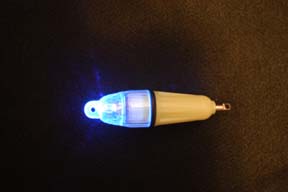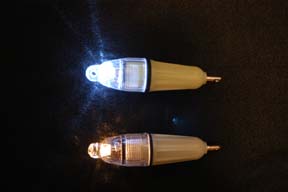 Recent research shows that fish see ultraviolet. In fact, scientists have declared that fish are the only animals on earth capable of seeing both infrared and ultra violet rays. The Norwalk Aquarium Society recently asked this fact as their monthly trivia question. Here's what it means to anglers. When we buy lures we can choose lures that are or aren't ultraviolet receptors or we can choose glow-in-the-dark lures designed to store light within the glow pigment of the lure. Glow-in-the-dark lures work great, especially after you have “charged” them with a bright light source (naturally with the sun, or an old camera strobe). Glow-in-the-dark lures also reflect UV rays, which make them a great choice for anglers searching for good deep-water colors. Ultraviolet, on the other hand, will reflect the available light, that allows the fish to see it without having to keep it charged.
Recent research shows that fish see ultraviolet. In fact, scientists have declared that fish are the only animals on earth capable of seeing both infrared and ultra violet rays. The Norwalk Aquarium Society recently asked this fact as their monthly trivia question. Here's what it means to anglers. When we buy lures we can choose lures that are or aren't ultraviolet receptors or we can choose glow-in-the-dark lures designed to store light within the glow pigment of the lure. Glow-in-the-dark lures work great, especially after you have “charged” them with a bright light source (naturally with the sun, or an old camera strobe). Glow-in-the-dark lures also reflect UV rays, which make them a great choice for anglers searching for good deep-water colors. Ultraviolet, on the other hand, will reflect the available light, that allows the fish to see it without having to keep it charged.At 400-feet is there light?
No and yes. For humans the answer is no, we don't have the right rods and cones in our eyes to see the all frequencies of light. For fish the answer is a resounding YES! Ultraviolet rays, the very same UV rays that cause cancer from over exposure, penetrates to great depths in an otherwise dark ocean. Ultraviolet light is on such a different light frequency it penetrates far greater depths, in the same way it can penetrate some types of clothing and cause skin cancer. Because UV light reaches greater depths it reflects off other objects, especially objects that have UV-enhanced coloring, like the Mr. Good Bar spreader bar. Ultraviolet lures, those containing special color pigments, are illuminated when UV reflects off of them. Basic white is a great color too, because it reflects UV better than dark, non-UV-enhanced lures. Anything that reflects the UV rays allows the fish see it, much like a freshly charged glow-in-the-dark lure.
 A recent TV documentary showed a diver with an ultraviolet spotlight shinning it on the bottom. Using nothing but a standard light source common to divers the scene was a stark contrast of gray and blacks. Using the ultraviolet light source suddenly revealed a wide spectrum of colors from red, purple and yellow. Using the light, they said, duplicates what the fish see. Personal research using mini underwater lights, the Trophy
Torchtm, has also proved to be an effective way of attracting halibut. Combined with the ultraviolet, glow-in-the-dark and even standard colored lures/baits, the underwater light has proven itself by continually bringing the fish to the bait or lure quicker. This fact was proven by Chris Batin & me, over a four year period while filming "Underwater Secrets of Catching Halibut, Rockfish & Lingcod." Using a light source helped us catch fish quicker, therefore allowing us to pick and choose and make better use of our precious time on the water. Without a light source or lure that reflects UV rays anglers must rely on scent or action to attract fish to their bait or lure.
A recent TV documentary showed a diver with an ultraviolet spotlight shinning it on the bottom. Using nothing but a standard light source common to divers the scene was a stark contrast of gray and blacks. Using the ultraviolet light source suddenly revealed a wide spectrum of colors from red, purple and yellow. Using the light, they said, duplicates what the fish see. Personal research using mini underwater lights, the Trophy
Torchtm, has also proved to be an effective way of attracting halibut. Combined with the ultraviolet, glow-in-the-dark and even standard colored lures/baits, the underwater light has proven itself by continually bringing the fish to the bait or lure quicker. This fact was proven by Chris Batin & me, over a four year period while filming "Underwater Secrets of Catching Halibut, Rockfish & Lingcod." Using a light source helped us catch fish quicker, therefore allowing us to pick and choose and make better use of our precious time on the water. Without a light source or lure that reflects UV rays anglers must rely on scent or action to attract fish to their bait or lure. The
original Trophy Torchtm
worked great. It used a AA battery and had a clear body. Two years ago I
introduced the Glow Torchtm
which incorporated a glow body to make it even more luminescent. Now, after
years of research, trying to find the perfect light source that shines brighter,
the Trophy Torch and Glow Torchtm
have been redesigned. Both lights will now incorporate LED technology for
brighter, longer lasting underwater light sources/attractors. The Trophy Torchtm
now offers a standard white LED, powered by 3 small button batteries. The Glow
Torchtm
now offers a 440 nanometer UV LED (black light). This is the world’s first
underwater black light used for the purpose of attracting fish.
The
original Trophy Torchtm
worked great. It used a AA battery and had a clear body. Two years ago I
introduced the Glow Torchtm
which incorporated a glow body to make it even more luminescent. Now, after
years of research, trying to find the perfect light source that shines brighter,
the Trophy Torch and Glow Torchtm
have been redesigned. Both lights will now incorporate LED technology for
brighter, longer lasting underwater light sources/attractors. The Trophy Torchtm
now offers a standard white LED, powered by 3 small button batteries. The Glow
Torchtm
now offers a 440 nanometer UV LED (black light). This is the world’s first
underwater black light used for the purpose of attracting fish.